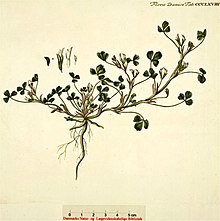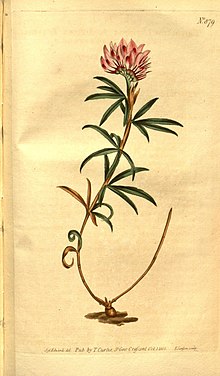Trifolium sect. Lotoidea
| Trifolium sect. Lotoidea | ||||||||||||
|---|---|---|---|---|---|---|---|---|---|---|---|---|

White clover ( Trifolium repens ) |
||||||||||||
| Systematics | ||||||||||||
|
||||||||||||
| Scientific name | ||||||||||||
| Trifolium sect. Lotoidea | ||||||||||||
| Crantz |
Trifolium sect. Lotoidea is a section in the genus Klee ( Trifolium ) in the subfamily of the butterflies (Faboideae). With around 99 species in the New World , Africa and Eurasia , it is the largest section of the genus Trifolium and the most taxonomically difficult. The species are so heterogeneous that the section has been divided into nine subsections and 13 series . Especially the classification of the American species is difficult. The main characteristics of the section are: umbrella-like inflorescence , stalked flowers with bracts and two- to many-seeded legumes . The section is considered the most evolutionarily primitive section of the genus Trifolium .
description


Vegetative characteristics
Species of the Lotoidea section are annual or perennial herbaceous plants . The stem axis is simple or branched . Some species form rhizomes .
Generative characteristics
The inflorescences are umbrella-like, head-like or spike-like . Bracts are present and have entire margins, divided into two or serrated. In the subsection Neolagopus there are a few species in which the bracts are completely absent or have receded into rudiments. The inflorescences are short or long stalked, rarely sessile.
The hermaphrodite flowers are zygomorphic and five-fold with a double flower envelope . The calyx is ten-nerved in almost all species, but rarely five or twenty-nerved. He is open, with a bare neck. The calyx teeth are designed the same, but unequal in some exceptional species. The corolla has the typical shape of the butterfly flower . The crown varies in color and does not fall off after anthesis . The ovary contains one to twelve ovules .
The legume will remain closed or tear open at one or both seams.
distribution
Clover species of the Lotoidea section can be found in almost the entire range of the genus Klee, in Europe, North and South America, Africa and Asia.
Systematics
The section Trifolium sect. Lotoidea was set up by Heinrich Johann Nepomuk von Crantz . Type species is Trifolium repens L. A synonym for Trifolium sect. Lotoidea Crantz is Trifolium sect. Amoria (Presl) Lojac.
Most of the original features of the species in the Lotoidea section have been preserved. The section is therefore considered to be the oldest and most evolutionarily primitive section of the genus. It is believed that all of the other sections developed directly from the lotoid .
The species of the Lotoidea section and their assignment according to Zohary and Heller 1984 are:








literature
- Michael Zohary, David Heller: The Genus Trifolium . The Israel Academy of Sciences and Humanities , Jerusalem 1984, ISBN 965-208-056-X .
Individual evidence
- ^ SL Welsh: New taxa and new nomenclatural combinations in the Utah flora . In: Rhodora . tape 95 , no. 883/884 , 1993, pp. 392-421 ( digitized version ).
- ↑ Ernest Small: Reduction of Ursia to Trifolium . In: Taxon . tape 36 , no. 3 , 1987, pp. 578-583 , JSTOR : 1221849 .
- ^ Joseph L. Collins, Thomas F. Wieboldt: Trifolium calcaricum (Fabaceae), a New Clover from Limestone Barrens of Eastern United States . In: Castanea . tape 57 , no. 4 , 1992, pp. 282-286 , JSTOR : 4033737 .
further reading
- F. Salimpour, G. Mostafavi, F. Sharifnia: Micromorphologic study of the seed of the genus Trifolium, section Lotoidea, in Iran. In: Pak J Biol Sci. , Volume 10, Issue 3, 2007, pp. 378-382. PMID 19069504 .
